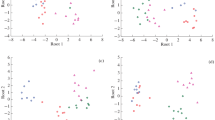Summary
The changes of the brain monoamines, norepinephrine (NE), dopamine (DA), and serotonin (5-HT), during acute asphyxia, caused by strangulation, anoxia, and drowning, were studied in the mouse.
In several asphyxiated animal groups significant linear correlation was found between the level of monoamines, NE, DA, and 5-HT, and the death process times or antemortem times were r=0.50, 0.98 (P<0.05), and 0.57, respectively.
It is concluded that the level of brain NE and DA increased in the mouse that died of asphyxia, and the level of 5-HT showed only an apparent decrease in anoxia groups as compared with the control group and showed a twice as high increase in drowning groups. Especially, there was a tendency that the longer the death process times or antemortem times, the higher was the level of DA.
Zusammenfassung
Die Konzentrationsänderung der Monoamine Norepinephrin (NE), Dopamin (DA) und Serotonin (5-HT) im Gehirn wurde während der akuten Asphyxie (Strangulation, Anoxie und Ertrinken) experimentell an Mäusen untersucht. In verschiedenen Versuchsgruppen wurde eine signifikante, lineare Abhängigkeit der Monoamin-Werte NE, DA, und 5-HT zur Länge des agonalen Stadiums beobachtet, wobei folgende Korrelationskoeffizienten errechnet wurden: r=0,50, 0,98, (P<0,05) und 0,57.
Hieraus wird geschlossen, daß die Konzentration des NE und 5-HT im Gehirn bei den asphyktischen Tieren zunimmt, die das 5-HT bei den Tieren unter Anoxie abfällt, hingegen einen etwa zweifachen Anstieg bei den Tieren aufweist, die ertranken. Darüber hinaus ließ sich eine Tendenz zu höheren DA-Werten feststellen, die in Abhängigkeit zur Länge der agonalen Phase steht.
Similar content being viewed by others
References
Brian RM Jr, Jones DR (1980) Cerebral energy metabolism in mallard ducks during apneic asphyxia: the role of oxygen concentration. Am J Physiol 239:R352–357
Cohen MM (1973) Biochemistry of cerebral anoxia, hypoxia, and ischemia. In: Cohen MM (ed) Monographs in neural sciences, vol 1. Karger, Basel, pp 1–49
Di Maio DJD, Di Maio VJM (1973) Two deaths caused by a lack of oxygen in an underground chamber. J Forens Sci 19:398–401
Gregory AL, Lois TM, Koperman AE (1982) Brain prostaglandin E2 and prostaglandin F2α following neonatal asphyxia in the guinea pig. Bio Neonata 42:8–14
Komura S, Fujimura K (1974) Heart rate and fatal course in rabbits asphyxiated by respiratory arrest. Tohoku J Exp Med 114:273–275
Oehmichen M (1980) Enzyme alterations in brain tissue during the early postmortem interval with reference to the histomorphology: Review of the literature. Z Rechtsmed 85:81–95
Sasa S, Blank CL (1977) Determination of serotonin and dopamine in mouse brain tissue by high performance liquid chromatography with electrochemical detection. Anal Chem 49:354–359
Sherman MM, McCormick JR, Berger RL (1977) VII. The Thorax. In: Tedeschi CG, Eckert WG, Tedeschi LG (eds) Forensic medicine—A study on trauma and environmental hazards. Saunders, Philadelphia, pp 190–210
Sloviter RS, Connor JD (1977) Postmortem stability of norepinephrine, dopamine, and serotonin in rat brain. J Nerochem 28:1129–1131
Spitz WU (1980) XII. Asphyxia. In: Spitz WU, Fisher RS (eds) Medicolegal investigation of death guidelines for the application of pathology to crime investigation, 2nd edn. C. Thomas, Springfield, pp 320–366
Van Wijk M, Kopf J (1981) Postmortem changes of 5-hydroxytryptamine and 5-hydroxyindoleacetic acid in mouse brain and their prevention by pargylin and microwave irradiation. Neurochem Res 6:425–430
Author information
Authors and Affiliations
Rights and permissions
About this article
Cite this article
Yoshimoto, K., Irizawa, Y., Itoh, N. et al. Central monoamines and the death process time (antemortem time) during asphyxia. Z Rechtsmed 93, 211–218 (1984). https://doi.org/10.1007/BF00200452
Received:
Issue Date:
DOI: https://doi.org/10.1007/BF00200452



